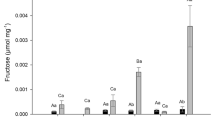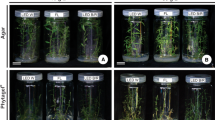Summary
Green and albino plants were regenerated from green and white tissues, respectively, of a chimeric,Episcia cupreata “Pink Brocade.” The green plants grew much faster in vitro than the albinos. The slower growth of albinos apparently was not the result of carbohydrate deficiency, as it could not be corrected by increased sucrose. Growth of the albinos was also not improved by supplementation with various amino acids, growth hormones, or Δ-aminolevulinic acid.
Similar content being viewed by others
References
Arnason, T. J.; Walker, G. W. R. An irreversible gene-induced plastid mutation. Can. J. Res. 27: 172–178; 1949.
Burk, L. G.; Menser, H. A. A dominant aurea mutation in tobacco. Tobacco Sci. 8: 101–104; 1964.
Murashige, T.; Skoog, F. A revised medium for rapid growth and bioassays with tobacco tissue cultures. Physiol. Plant 15: 473–497; 1962.
Evans, A.; Smith, H. Localization of phytochrome in etioplasts and its regulationin vitro of gibberellin levels. Proc. Natl. Acad. Sci. U.S.A. 73: 138–142; 1976.
Stoddart, J. L. The association of gibberellin-like activity with the chloroplast fraction of leaf homogenates. Plants 81: 106–112; 1968.
Luckwill, L. C. The effect of certain growth regulators on growth and apical dominance of young apple trees. J. Hort. Sci. 43: 91–101; 1968.
Jones, R. L.; Lang, A. Extractable and diffusible gibberellins from light and dark grown pea seedlings. Plant Physiol. 43: 629–634; 1968.
Went, F. W.; Thimann, K. V. Phytohormones. New York: MacMillan; 1937.
Walles, B. Macromolecular physiology of plastids. IV. On amino acid requirements of lethal chloroplast mutants in barley. Hereditas 50: 317–344; 1963.
von Wettstein, D. Nuclear and cytoplasmic factors in development of chloroplast structure and fraction. Can. J. Bot. 39: 1537–1545; 1961.
Clayton, R. K. Molecular physics in photosynthesis. New York: Blaisdell Publishing Co.; 1975; 4.
Siegelman, H. W.; Hendricks, S. B. Photocontrol of anthocyanin formation in turnip and red cabbage seedlings. Plant Physiol. 32: 393–398; 1957.
Siegelman, H. W.; Hendricks, S. B. Photocontrol of anthocyanin synthesis in apple skin. Plant Physiol. 33: 185–190; 1958.
Author information
Authors and Affiliations
Additional information
Paper of the Journal Series, New Jersey Agricultural Station, Cook College, Rutgers—The State University, New Brunswick, New Jersey 08903.
Rights and permissions
About this article
Cite this article
Chin, CK. Growth behavior of green and albino plants ofEpiscia cupreata “Pink brocade” in vitro. In Vitro 16, 847–850 (1980). https://doi.org/10.1007/BF02619421
Received:
Accepted:
Issue Date:
DOI: https://doi.org/10.1007/BF02619421




